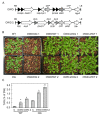Ectopic Expression of OLEOSIN 1 and Inactivation of GBSS1 Have a Synergistic Effect on Oil Accumulation in Plant Leaves
- PMID: 33803467
- PMCID: PMC8000217
- DOI: 10.3390/plants10030513
Ectopic Expression of OLEOSIN 1 and Inactivation of GBSS1 Have a Synergistic Effect on Oil Accumulation in Plant Leaves
Abstract
During the transformation of wild-type (WT) Arabidopsis thaliana, a T-DNA containing OLEOSIN-GFP (OLE1-GFP) was inserted by happenstance within the GBSS1 gene, resulting in significant reduction in amylose and increase in leaf oil content in the transgenic line (OG). The synergistic effect on oil accumulation of combining gbss1 with the expression of OLE1-GFP was confirmed by transforming an independent gbss1 mutant (GABI_914G01) with OLE1-GFP. The resulting OLE1-GFP/gbss1 transgenic lines showed higher leaf oil content than the individual OLE1-GFP/WT or single gbss1 mutant lines. Further stacking of the lipogenic factors WRINKLED1, Diacylglycerol O-Acyltransferase (DGAT1), and Cys-OLEOSIN1 (an engineered sesame OLEOSIN1) in OG significantly elevated its oil content in mature leaves to 2.3% of dry weight, which is 15 times higher than that in WT Arabidopsis. Inducible expression of the same lipogenic factors was shown to be an effective strategy for triacylglycerol (TAG) accumulation without incurring growth, development, and yield penalties.
Keywords: fatty acids; granule bound starch synthase; metabolic engineering; oleosin; triacylglycerol.
Conflict of interest statement
The authors declare no conflict of interest.
Figures



Similar articles
-
Intron-mediated enhancement of DIACYLGLYCEROL ACYLTRANSFERASE1 expression in energycane promotes a step change for lipid accumulation in vegetative tissues.Biotechnol Biofuels Bioprod. 2023 Oct 14;16(1):153. doi: 10.1186/s13068-023-02393-1. Biotechnol Biofuels Bioprod. 2023. PMID: 37838699 Free PMC article.
-
Sugar Potentiation of Fatty Acid and Triacylglycerol Accumulation.Plant Physiol. 2017 Oct;175(2):696-707. doi: 10.1104/pp.17.00828. Epub 2017 Aug 25. Plant Physiol. 2017. PMID: 28842550 Free PMC article.
-
Engineering the production of conjugated fatty acids in Arabidopsis thaliana leaves.Plant Biotechnol J. 2017 Aug;15(8):1010-1023. doi: 10.1111/pbi.12695. Epub 2017 Mar 15. Plant Biotechnol J. 2017. PMID: 28083898 Free PMC article.
-
Metabolic engineering of sugarcane to accumulate energy-dense triacylglycerols in vegetative biomass.Plant Biotechnol J. 2016 Feb;14(2):661-9. doi: 10.1111/pbi.12411. Epub 2015 Jun 8. Plant Biotechnol J. 2016. PMID: 26058948 Free PMC article.
-
Senescence-inducible LEC2 enhances triacylglycerol accumulation in leaves without negatively affecting plant growth.Plant Biotechnol J. 2015 Dec;13(9):1346-59. doi: 10.1111/pbi.12354. Epub 2015 Mar 18. Plant Biotechnol J. 2015. PMID: 25790072 Free PMC article.
Cited by
-
Inducible expression of DEFECTIVE IN ANTHER DEHISCENCE 1 enhances triacylglycerol accumulation and lipid droplet formation in vegetative tissues.Plant J. 2025 Mar;121(5):e70088. doi: 10.1111/tpj.70088. Plant J. 2025. PMID: 40052427 Free PMC article.
-
Ectopic expression of WRINKLED1 in rice improves lipid biosynthesis but retards plant growth and development.PLoS One. 2022 Aug 19;17(8):e0267684. doi: 10.1371/journal.pone.0267684. eCollection 2022. PLoS One. 2022. PMID: 35984829 Free PMC article.
-
Enhancing lipid production in plant cells through automated high-throughput genome engineering and phenotyping.Plant Cell. 2025 Feb 13;37(2):koaf026. doi: 10.1093/plcell/koaf026. Plant Cell. 2025. PMID: 39899469
-
The ubiquitin-protein ligase MIEL1 localizes to peroxisomes to promote seedling oleosin degradation and lipid droplet mobilization.Proc Natl Acad Sci U S A. 2023 Jul 18;120(29):e2304870120. doi: 10.1073/pnas.2304870120. Epub 2023 Jul 6. Proc Natl Acad Sci U S A. 2023. PMID: 37410814 Free PMC article.
References
-
- Parajuli S., Kannan B., Karan R., Sanahuja G., Liu H., Garcia-Ruiz E., Kumar D., Singh V., Zhao H., Long S., et al. Towards oilcane: Engineering hyperaccumulation of triacylglycerol into sugarcane stems. GCB Bioenergy. 2020;12:476–490. doi: 10.1111/gcbb.12684. - DOI
Grants and funding
LinkOut - more resources
Full Text Sources
Other Literature Sources
Molecular Biology Databases
Miscellaneous

